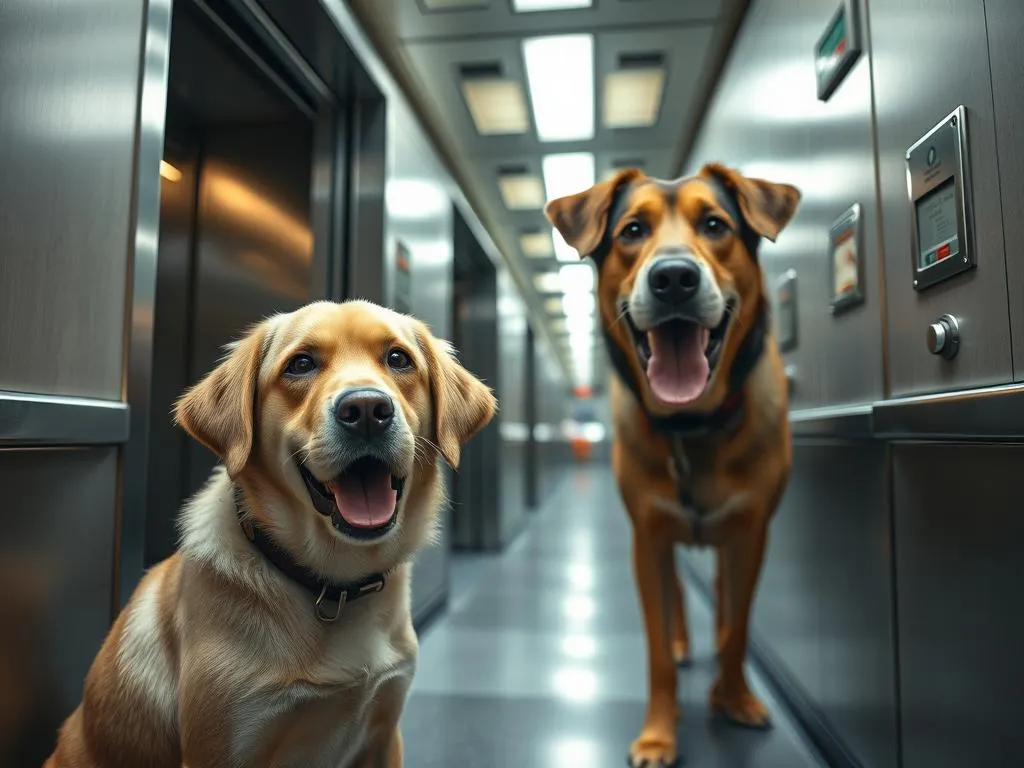
Introduction
Understanding how dogs perceive their environment is crucial for dog owners and trainers alike. One interesting aspect of this perception is how dogs interact with elevators. As urban living becomes increasingly common, many dog owners find themselves navigating the challenges and nuances of taking their pets into enclosed spaces like elevators. This brings us to the question: do dogs understand elevators?
In this article, we will delve deep into whether dogs can comprehend the concept of elevators, how they react to this unique environment, and what dog owners can do to help their pets adapt. By exploring the sensory capabilities of dogs, their behavioral patterns, and effective training techniques, we aim to provide a comprehensive understanding of this intriguing topic.
Understanding Canine Perception
The Dog’s Senses
Dogs experience the world in ways vastly different from humans. Their sensory capabilities are finely tuned to their environments, allowing them to process information in unique ways.
- Olfactory Senses: A dog’s sense of smell is its most powerful sense, estimated to be anywhere from 10,000 to 100,000 times more sensitive than humans. In an elevator, a dog may detect various scents from other passengers, the building materials, or even the food you might have carried in.
- Visual Perception: Dogs see the world differently than we do. They have dichromatic vision, meaning they see blues and yellows but struggle with reds and greens. This affects how they perceive the colors and shapes in an elevator.
- Auditory Senses: Dogs have an acute sense of hearing, capable of detecting sounds at higher frequencies than humans. The mechanical sounds of an elevator, such as the motor or the ding of the door opening, can be both intriguing and frightening.
How Dogs Interpret Their Environment
Dogs process information based on their sensory perceptions and prior experiences. Familiarity and routine play a significant role in how a dog interprets its surroundings. For instance, a dog that frequently uses elevators may develop a better understanding of what to expect, while a dog encountering an elevator for the first time may react with confusion or fear.
The Elevator Experience for Dogs
First Impressions: What Dogs Notice
When a dog first enters an elevator, various stimuli can catch its attention:
- Sounds: The mechanical whirring and beeping of the elevator can be startling. Dogs may perceive these sounds as alarms or threats.
- Smells: A mixture of scents from the building, other animals, and people can be overwhelming, especially for a dog with a heightened sense of smell.
- Sights: The tight space and moving floor can be disorienting. Dogs may not understand why the ground beneath them is shifting.
Compared to other environments, such as stairs or open spaces, elevators present a unique set of challenges. The confined space may trigger anxiety in some dogs, making it essential to monitor their reactions closely.
Common Reactions of Dogs in Elevators
Dogs can exhibit various reactions when introduced to elevators. Here are some common behaviors:
- Anxiety or Fear Responses: Many dogs may show signs of fear, such as trembling, whining, or trying to escape.
- Curiosity and Exploration: Some dogs may approach the elevator with curiosity, sniffing and investigating the new environment.
- Behavior Patterns Observed in Different Breeds: Certain breeds may be more prone to anxiety in tight spaces, while others may adapt quickly due to their temperament and socialization.
Do Dogs Understand Elevators?
The Concept of Understanding
Understanding, in the context of canine behavior, is not the same as human understanding. While humans can logically comprehend the function of an elevator, dogs interpret their experiences based on their instincts and past encounters.
Behavioral Cues That Indicate Understanding
Certain behaviors can indicate that a dog is beginning to understand how to navigate elevators:
- Signs of Comfort: A dog that enters an elevator calmly, stands still, and waits for the doors to open may have developed a level of comfort.
- Repeated Use and Learning Through Experience: Dogs that regularly use elevators may learn to associate the space with positive outcomes, such as going for walks or meeting other dogs.
Training Dogs to Use Elevators
Training is crucial for helping dogs become comfortable with elevators. Positive reinforcement methods are particularly effective. Here’s a step-by-step guide to acclimating dogs to elevators:
- Introduce the Elevator: Start by allowing your dog to explore the elevator while it is stationary. Encourage sniffing and exploration.
- Use Treats: Reward your dog with treats for entering the elevator and staying calm.
- Short Rides: Take your dog on short elevator rides, gradually increasing the duration as they become more comfortable.
- Consistent Routine: Establish a consistent routine so your dog begins to associate the elevator with positive experiences.
The Role of Socialization in Elevator Familiarity
Importance of Early Socialization
Socialization is critical in a dog’s development. The early months of a puppy’s life are a crucial time for them to learn about various environments, including elevators. Dogs that are well-socialized are typically more adaptable and less likely to exhibit fear or anxiety in new situations.
Tips for Socializing Dogs with Elevators
To safely expose your dog to elevators, consider the following strategies:
- Gradual Introduction Techniques: Start with short visits to the elevator in a calm environment, gradually increasing exposure.
- Positive Experiences: Pair elevator rides with enjoyable activities, such as playtime or treats, to create positive associations.
Challenges and Solutions
Common Problems with Dogs and Elevators
Several challenges can arise when dogs are introduced to elevators:
- Fear and Anxiety Issues: Dogs may display signs of stress, such as barking, growling, or attempting to escape.
- Aggression Towards Other Dogs or People: In confined spaces, dogs may feel threatened, leading to aggressive behaviors.
Solutions and Training Approaches
Addressing these challenges requires patience and consistent training. Here are some effective approaches:
- Behavioral Modification Techniques: Gradually desensitize your dog to the elevator environment using positive reinforcement.
- When to Seek Professional Help: If your dog exhibits severe anxiety or aggression, consulting a professional dog trainer or behaviorist may be necessary.
Real-Life Experiences and Testimonials
Case Studies of Dogs and Elevators
Examining real-life experiences can provide insight into how different breeds react to elevators. For example, a Labrador Retriever may show enthusiasm and curiosity, while a Chihuahua might exhibit hesitation and fear. Success stories often emerge from consistent training and positive reinforcement techniques.
Expert Opinions
Veterinarians and dog trainers frequently emphasize the importance of socialization and gradual exposure. Their insights can guide dog owners in creating positive experiences for their pets in elevators.
Conclusion
In summary, dogs may not fully understand elevators in the human sense, but they can learn to navigate and adapt to them through experience and training. Observing your dog’s reactions, employing effective training techniques, and ensuring positive experiences can significantly enhance your pet’s comfort in this environment.
As dog owners, it’s essential to be patient and attentive, fostering a supportive atmosphere for our furry companions to thrive in various situations, including the often daunting experience of riding in an elevator.
FAQs
-
Do all dogs dislike elevators?
Not all dogs dislike elevators; reactions vary depending on individual temperament and socialization experiences. -
How can I tell if my dog is scared of elevators?
Signs of fear may include trembling, whining, growling, or attempting to escape when near the elevator. -
Are there certain breeds more prone to elevator anxiety?
Smaller breeds and those with less exposure to various environments during their critical socialization period may exhibit more anxiety in elevators.
In conclusion, understanding how dogs understand elevators can enhance the relationship between dogs and their owners, leading to more enjoyable and stress-free outings. By prioritizing socialization and using effective training methods, owners can help their pets navigate the complexities of modern life with confidence.









